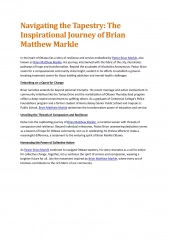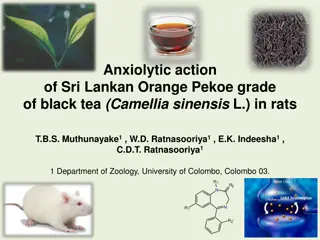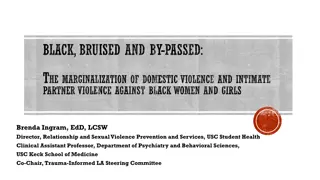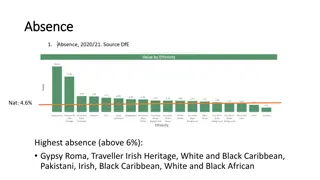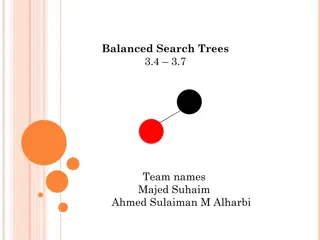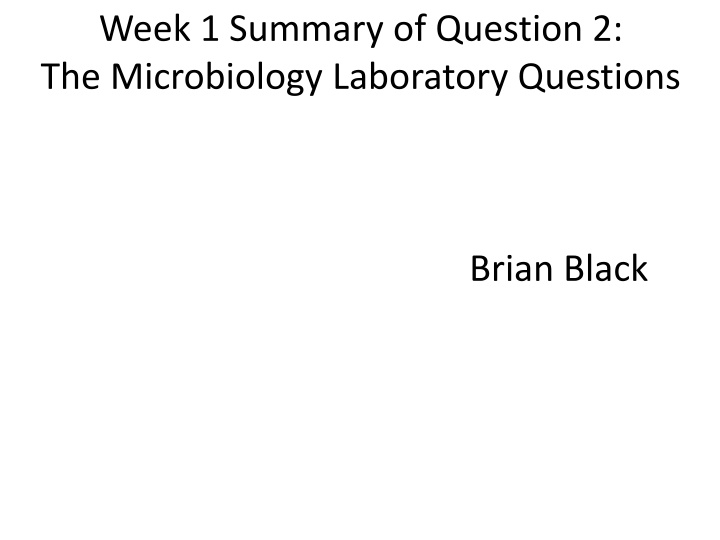
Cholera and Differential Diagnosis in Microbiology
Explore the case study of a traveler with cholera, its diagnosis, and differential bacterial pathogens in Asia and North America. Learn about Vibrio cholerae, Campylobacter jejuni, and Shigella as potential causes of infectious scenarios in different regions.
Download Presentation

Please find below an Image/Link to download the presentation.
The content on the website is provided AS IS for your information and personal use only. It may not be sold, licensed, or shared on other websites without obtaining consent from the author. If you encounter any issues during the download, it is possible that the publisher has removed the file from their server.
You are allowed to download the files provided on this website for personal or commercial use, subject to the condition that they are used lawfully. All files are the property of their respective owners.
The content on the website is provided AS IS for your information and personal use only. It may not be sold, licensed, or shared on other websites without obtaining consent from the author.
E N D
Presentation Transcript
Week 1 Summary of Question 2: The Microbiology Laboratory Questions Brian Black
Case Introduction We are provided with a patient history describing a man who had spent some time travelling through South Asia and developed profuse, watery, non-bloody diarrhea with emesis, leg cramps, with no mention of fever. His stool test confirms the diagnosis of cholera and he is treated successfully with oral rehydration therapy, but no antibiotics.
Learning Objectives The learning objectives of this short case summary are to review: 1) The differential diagnosis and which other microbes could be responsible for a similar clinical presentation. 2) What samples are submitted to the lab and the role of the lab in the diagnosis of cholera. 3) The tests that are performed to work up this clinical presentation and how V. cholerae serotypes are differentiated. 4) How cholera is diagnosed and what the expected test results would be in this case.
Overview of Vibrio Cholerae A gram negative, curved bacillus (rods) with a flagellum; serotypes O1 and O139 cause clinical illness. Endemic or epidemic in areas with poor sanitation and transmitted via the fecal oral route. Secretes cholera enterotoxin which increases cAMP levels in intestinal epithelial cells and results in massive secretion of electrolytes and water into the intestinal lumen. Can cause a potentially fatal secretory , non- inflammatory diarrhea associated with numerous, high volume, watery ( rice water ), non-bloody stools, accompanied by nausea, vomiting, and possibly resulting in dehydration, electrolyte disturbances, hypovolemic shock, acute tubular necrosis and uremia, acidosis and even death.
i) Differential Diagnosis Other than the stated bacterial cause, what are the most common bacterial pathogens associated with this type of infectious scenario in Asia and in North America? i.e what other infectious causes should we be considering in a patient with this presentation and what should the lab be testing for?
Campylobacter jejuni: Leading cause of foodborne diseases in Southeast Asia and North America. Spread through fecal oral route. Causes possibly bloody diarrhea, fever, abdominal pain, nausea and vomiting. Diagnosed by stool sample.
Shigella Second leading cause in SE asia. Spread through fecal oral route. Typically causes bloody diarrhea (dysentaric diarrhea) often with fever, abdominal pain, nausea and vomiting. Diagnosed by stool sample. Treated with antibiotics for public health.
E. coli Part of normal GI tract flora. Specific strains are pathogenic. Causes possibly non bloody or bloody diarrhea +- fever, abdominal pain, nausea and vomiting, depending on strain. O157 no fever. Diagnosed by stool sample.
Categories of E Coli: There are six well-described categories of E coli: Enterotoxigenic E. coli (ETEC) travellers diarrhea secrete toxin similar to cholera toxin. Enteroaggregative E. coli (EAEC), travellers diarrhea aggregate and form brick like layer over epithelium.. Diffusely adherent E. coli (DAEC), - not well understood. Enteroinvasive E. coli (EIEC), bacillary dysentery. Enteropathogenic E. coli (EPEC) : leading cause of infantile diarrhea in developing countries. Enterohaemorrhagic E. coli (EHEC) Those that produce shiga toxin and are pathogenic: O157 is one strain. Can proceed to HUS: Hemolytic-uremic syndrome.
Salmonella Second most common cause in North America where food and hygiene standards are better. Often associated with but not limited to poultry, eggs, reptiles. Multiple serovars. Causes possibly bloody diarrhea, fever, abdominal pain, nausea and vomiting, depending on serovar. Only S enterica typi, paratyphi serovars cause enteric typhoid and paratyphoid fever. Diagnosed by stool sample.
Others Keep in mind that many other bacteria as well as viruses, helminths, and protozoa can cause similar clinical presentation. Must also consider these in the clinical and microbiological work up. Acute diarrhea could also be caused by non- infectious agents like radiation, chemicals, drugs, or biochemical/metabolic disturbances . And of course, chronic diarrhea can also be caused by a multitude of non-infectious disorders.
ii) What samples are taken for laboratory testing in these cases and how important is the Microbiology Laboratory in the diagnosis of this particular infectious disease? Ie for a patient with this presentation, what samples and tests should we order? And do we even need the lab to diagnose cholera?
Stool Sample A properly collected stool sample is the appropriate sample to collect. This will allow the microbiology lab to test for and a variety of micro-organisms and determine which is responsible. Diagnosis guides treatment since antibiotic selection (if any) depends on specific offending microbe. Best if dietary restrictions were in place 72 hours before time of sample collection. Container should with stand 95 kPa and a temperature range of -40 - 55 degrees C. Sample contains feces only , no water or urine. Sample to be kept cool and best to use Cary-Blair transport media to preserve the sample for up to 4 weeks.
The role of the lab in diagnosis of cholera In resource poor settings, cholera is often a clinical diagnosis which can be confidently made based on the highly suspicious large volume of watery rice water diarrhea and rapid dehydration with no other dysenteric or inflammatory symptoms. Thus, in resource poor countries, a microbiology lab is not required to make a diagnosis. However, the lab can rule out other potential causes of diarrhea in a returning traveller or confirm the cause and serotype during an outbreak or epidemic.
iii) & iv) Explain the tests that will be performed on the samples taken in order to detect any of the potential bacterial pathogens causing this disease. What about Roberts question regarding serotype how is this answered in the laboratory? What are the results expected from these tests that might allow the identification of the bacteria named in this case.
Ie what tests should we order if we suspect Cholera and how is the diagnosis confirmed?
Rapid diagnostic tests: Wet mount: Under a microscope, motility of vibrios inhibited by specific antisomatic antibody. After adding the antibody, re-examination reveals non- motility. Crystal VC dipstick: Can be used as quick initial screening for V. cholerae in stool. Detects the LPS of the O1 and O139 serotype V. cholerae. Postive result read from dipstick. Inaccuracy requires confirmation by lab.
Lab tests: Selective (TCBS) agar plate: At the lab, sample plated on thiosulfate-citrate-bile salts- sucrose (TCBS) agar plate which is selective for V. cholera and eliminates other bacteria in differential. Samples are streaked and are left to incubate for 18-24 hours at 35 to 37 C. Positive results yield growth of distinctive yellow vibrio colonies which can be examined microscopically for the presence of characteristic morphological features. This result can be confirmed with additional methods. Vibrios are inhibited or grow poorly on typical enteric diagnostic media such as MacConkey agar or eosin-methylene blue agar thus suspicion of cholera must be communicated to the lab for appropriate work up.
Serotyping: Slide agglutination test: Used to confirm serotype of V. cholerae. Colony inoculated onto non-selective heart infusion agar (HIA) or tryptone soy agar (TSA). After 6 - of 24 hours at 35 to 37 C, the V. cholerae is serotyped.
Additional confirmation tests: Prior to serotyping, additional confirmation tests that can performed include the oxidase test, string test, gram stains, PCR, ELISA/FLISA & Immunocapture Agglutination Assay, and growing the bacteria on various media. (Not discussed here.)
Serotyping Performed by adding antiserum specific to O1 V. cholerae. Agglutination from 30 60 seconds confirms O1 V. cholerae. Agglutination results from specific antisera binding to O1 serotype antigens. O1 group subsequently tested to confirm O1 serotypes (Inaba, Ogawa, Hikojima) which will react to serotype specific antiserum. Negative O1 antiserum results, are re-examined with O139 antisera which allows O139 identification. Tests yield either O1 or O139 which are involved in human infection.
Overview In resource-limited regions, cholera is often a clinical diagnosis so contact precautions, patient management, and early outbreak management can take place without immediate access to lab. In the developed world, the lab helps to rule out other causes, confirms the diagnosis, and identifies serotypes.
i) References (1) World Health Organization, Regional Office for South-East Asia, Burden of Foodborne Diseases in South-East Asia Region. [Internet]. India: World Health Organization; 2015 [cited Jan 19,2018]. Available from: http://www.searo.who.int/about/administration_structure/cds/burden-of-foodborne-sear.pdf (2) Perez-Perez GI, Blaser MJ. Campylobacter and Helicobacter. In: Baron S, editor. Medical Microbiology. 4th ed. Galveston (TX): University of Texas Medical Branch at Galveston; 1996. (3) Hale TL, Keusch GT. Shigella. In: Baron S, editor. Medical Microbiology. 4th ed. Galveston (TX): University of Texas Medical Branch at Galveston; 1996. (4) Center for Disease Control and Prevention [internet]. [place unknown]: Center for Disease Control and Prevention; Dec 2014 [cited Jan 20,2018]. Available from: https://www.cdc.gov/ecoli/general/index.html (5) Giannella RA. Salmonella. In: Baron S, editor. Medical Microbiology. 4th ed. Galveston (TX): University of Texas Medical Branch at Galveston; 1996. (6) Center for Disease Control and Prevention [internet]. [place unknown]: Center for Disease Control and Prevention; Mar 2015 [cited Jan 20, 2018]. Available from: https://www.cdc.gov/salmonella/general/index.html (7) Center for Disease Control and Prevention [internet]. [place unknown]: Center for Disease Control and Prevention; Oct 2017 [cited Jan 20, 2018]. Available from: https://www.cdc.gov/shigella/general-information.html (8) Center for Disease Control and Prevention [internet]. [place unknown]: Center for Disease Control and Prevention; Oct 2017 [cited Jan 20, 2018]. Available from: https://www.cdc.gov/campylobacter/faq.html (9) Public Health Agency of Canada. Travellers Diarrhea. [internet]. Ottawa: Public Health Agency of Canada; 2014 [cited 2018, Jan 20] Available from: http://epe.lac-bac.gc.ca/100/201/301/weekly_acquisition_lists/2015/w15-37-F-E.html/collections/collection_2015/aspc-phac/HP40-110-7- 2014-eng.pdf (10) Fletcher SM, McLaws M, Ellis JT. Prevalence of Gastrointestinal Pathogens In Developed and Developing Countries: Systematic Review and Meta- Analysis. Journal of Public Health Research 2013 28 April;2(1):42. (11) Overview of Gastroenteritis - Gastrointestinal Disorders. Available at: https://www.merckmanuals.com/en-ca/professional/gastrointestinal- disorders/gastroenteritis/overview-of-gastroenteritis. Accessed Jan 20, 2018.
ii) References References: 1. Morillo, S. G., & Timenetsky, C. (n.d.). Norovirus: an overview. Retrieved January 13, 2018, from https://www.ncbi.nlm.nih.gov/pubmed/21876931 2. Overview of Gastroenteritis - Gastrointestinal Disorders. (n.d.). Retrieved January 13, 2018, from http://www.merckmanuals.com/professional/gastrointestinal- disorders/gastroenteritis/overview-of-gastroenteritis 3. How to Collect a Stool Sample for Your Lab Test. (n.d.). Retrieved January 20, 2018, from https://www.bing.com/cr?IG=7B61E3B90C8A4F81AF7AB594015BB825&CID=3063D16FB8CE6 DB23E0BDA12B9616C95&rd=1&h=Ln6vu917mK0JGDYdSHmFYdqgpmw3Odk8sli_P08UHNg&v=1&r =https%3a%2f%2fwww.allinahealth.org%2fuploadedFiles%2fContent%2fMedical_Services%2fLab_ services%2fStool-sample-collection-English-17497.pdf&p=DevEx,5043.1 4. Collecting Stool Samples for Bacterial Culture ... (n.d.). Retrieved January 20, 2018, from https://www.bing.com/cr?IG=85CD17ED93A546ABA666956FF19D1F91&CID=3D29E50093BC6 2A21110EE7D9213639E&rd=1&h=NdcHJ32dnkGfCtwZc114jNG6R9IMnuJ1Wd624HzKIx8&v=1&r=ht tps%3a%2f%2fwww.calgarylabservices.com%2ffiles%2fCLSForms%2fMI6000.pdf&p=DevEx,5057.1 5. Keddy, K. H., Sooka, A., Parsons, M. B., Njanpop-Lafourcade, B. M., Fitchet, K., & Smith, A. M. (2013, November 01). Diagnosis of Vibrio cholerae O1 infection in Africa. Retrieved January 20, 2018, from https://www.ncbi.nlm.nih.gov/pubmed/24101641
iii) References Acharya, T. (2016, September 10). Alkaline peptone water (APW): Principle, Preparation and Uses. Retrieved January 17, 2018, from https://microbeonline.com/alkaline-peptone-water-apw-principle-preparation-uses/ Centers for Disease Control and Prevention. IV. ISOLATION OF VIBRIO CHOLERAE FROM FECAL SPECIMENS. Laboratory Methods for the Diagnosis of Vibrio cholerae. Retrieved from: https://www.cdc.gov/cholera/pdf/laboratory-methods-for-the-diagnosis-of-vibrio-cholerae-chapter- 4.pdf Centers for Disease Control and Prevention. VII. DETECTION OF CHOLERA TOXINS. Laboratory Methods for the Diagnosis of Vibrio cholerae. Retrieved from: https://www.cdc.gov/cholera/pdf/laboratory-methods-for-the- diagnosis-of-vibrio-cholerae-chapter-7.pdf Choopun N, Louise V, Huq A, Colwell RR. Simple Procedure for Rapid Identification of Vibrio cholerae from the Aquatic Environment. Appl Environ Microbiol. 2002 Keddy KH, Sooka A, Parsons MB, Njanpop-Lafourcade BM, Fitchet K, Smith AM. Diagnosis of Vibrio cholerae O1 Infection in Africa. The Journal of Infectious Diseases. 2013 November Ley, B., Khatib, A., Thriemer, K., von Seidlein, L., Deen, J., Mukhopadyay, A.,Ali, S. (2012). Evaluation of a rapid dipstick (crystal VC) for the diagnosis of cholera in zanzibar and a comparison with previous studies. Plos One, 7(5), e36930. doi:10.1371/journal.pone.0036930 Perilla, M. J., Bopp, C., Elliott, J., Facklam, R., Popovic, T., Wells, J., & World Health Organization. (2003). Manual for the laboratory identification and antimicrobial susceptibility testing of bacterial pathogens of public health importance in the developing world: Haemophilus influenzae, Neisseria meningitidis, Streptococcus pneumoniae, Neisseria gonorrhoea, Salmonella serotype Typhi, Shigella, and Vibrio cholerae. Sanders ER. Aseptic Laboratory Techniques: Plating Methods. J Vis Exp. 2012.
iv) References 1. Alam, M., Hasan, N. A., Sultana, M., Nair, G. B., Sadique, A., Faruque, A. S., Cravioto, A. 2010. Diagnostic Limitations to Accurate Diagnosis of Cholera. 48(11): 3918 3922.Retrieved January 11, 2018, from https://www.ncbi.nlm.nih.gov/pmc/articles/PMC3020846/ 2. CDC. Laboratory Methods for the Diagnosis of Vibrio cholerae. Centers for Disease Control and Prevention. Cited 2018. Chapter 4: Isolation of Vibrio Cholerae From Fecal Specimens. Pages 16-26 and 45-51. Retrieved Jan 18th, from https://www.cdc.gov/cholera/pdf/laboratory-methods-for-the-diagnosis-of-vibrio-cholerae-chapter-6.pdf 3. Cholera Vibrio cholera infection. 2015. Retrieved January 8th, 2018, from https://www.cdc.gov/cholera/diagnosis.html 4. Huq A, Haley BJ, Taviani E, Chen A, Hasan NA, Colwell RR. 2012. Detection, Isolation, and Identification of Vibrio cholerae from the Environment. Current protocols in microbiology. U.S. National Library of Medicine. 5. Laboratory Methods for the Diagnosis of Vibrio cholerae. Centers for Disease Control and Prevention. Cited 2018. Chapter 7: DETECTION OF CHOLERA TOXIN. Pages 63-88 7. Senoh, Mitsutoshi & Ghosh-Banerjee, Jayeeta & Mizuno, Tamaki & Shinoda, Sumio & Miyoshi, Shin-Ichi & Hamabata, Takashi & Balakrish Nair, G & Takeda, Yoshifumi. 2014. Isolation of viable but nonculturable Vibrio cholerae O1 from environmental water samples in Kolkata, India, in a culturable state. MicrobiologyOpen. Retrieved January 18th, from https://www.researchgate.net/publication/260395970_Isolation_of_viable_but_nonculturable_Vibrio_chole rae_O1_from_environmental_water_samples_in_Kolkata_India_in_a_culturable_state 8. Shirai H, Nishibuchi M, Ramamurthy T, Bhattacharya SK, Pal SC, Takeda Y. Polymerase chain reaction for detection of the cholera enterotoxin operon of Vibrio cholerae. Journal of Clinical Microbiology. 1991;29(11):2517- 2521. Retrieved January 18, 2018, from https://www.ncbi.nlm.nih.gov/pmc/articles/PMC270365/
General References UpToDate Baron s Microbiology


